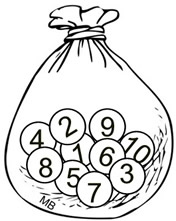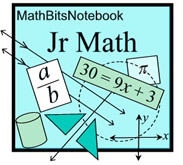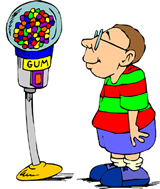|
There are 10 chips in a bag, numbered from 1 to 10.
Draw a numbered chip
from the bag:

The sample space is:

|
What is the probability
of drawing the chip
numbered 7?

The probability will
be "one out of 10"
or

|
What is the probability
of drawing any chip
number that is not
numbered 7?
The probability will
be "nine out of 10"
or

|
If we combine (add) the probability of drawing a 7 with the probability of not drawing a 7,
we get the probability of drawing all of the chips, 100%, or 1.

When asked to find the probability that an event did NOT occur,
the answer will be 1 minus the probability that the event did occur. |
The probability of not drawing the 7,
is the probability of what is "left in the sample space", or

 |
Since the sum of probabilities of all possible events in a sample space equals 1,
the probability that
event A will not occurs is equal to 1 minus the probability that event A will occur.
|
|
In future courses, you will see that this situation of dealing with "NOT"
is defined as being a "complement".
"The complement of event A is everything else in the sample space that is NOT in event A."


A die is rolled. What is the probability of not rolling a 6? |
P(6) = 1/6
P(not 6) = 1 - 1/6 = 5/6 |

A spinner is divided into 4 sections of equal size.
What is the probability of not spinning a 2? |
|
P(spinning 2) = 1/4
P(not spinning 2) = 1 - 1/4 = 3/4 |


A gum ball machine contains gum balls of five different colors:
36 red, 44 white, 15 blue, 20 green, and 5 orange.
There are 120 gum balls in total in the machine.
The machine dispenser randomly selects one gum ball.
What is the probability that the gum ball selected is:
|
|
a.) green? a.) probability of green is 20/120 = 1/6.
b.) not green? b.) probability of not green is 1 - 1/6 = 5/6.
c.) not orange? c.) probability of not orange is 1 - P(orange) = 1 - 5/120 = 1 - 1/24 = 23/24.
d.) orange? d.) probability of orange is 1/24.
e.) red, white, or blue?
e.) probability of red, white or blue is 36/120 + 44/120 + 15/120 = 95/120 = 19/24.
f.) not a color in the flag of the USA?
f.) use the "complement" of the answer to part e. 1 - 19/24 = 5/24.
|

NOTE: The re-posting of materials (in part or whole) from this site to the Internet
is copyright violation
and is not considered "fair use" for educators. Please read the "Terms of Use". |
|









